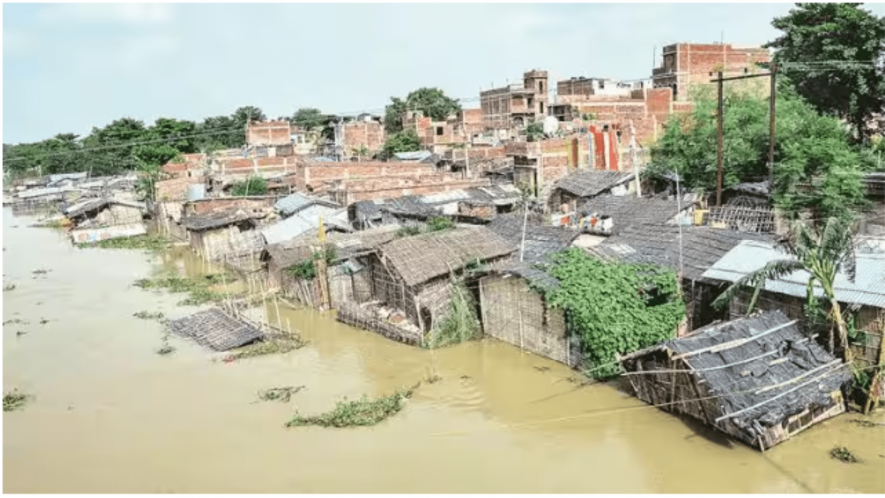Bihar: Thousands Hit by Flood-Like Situation

Image Courtesy: PTI
Patna: After heavy rains in the catchment areas of major rivers in neighbouring Nepal and Bihar over the past four days, thousands of people are grappling with a flood-like situation in the northern and eastern parts of the state.
The major rivers, including the Ganga, Koshi, Bagmati, Gandak, Burhi Gandak, Mahananda, Bhuthi-Balan, Kamla Balan, Masan, and Parman, are all swollen. The rivers have surged beyond the danger mark in some locations, such as Koshi, Bagmati, and Gandak. Authorities have issued alerts and urged residents in low-lying areas near the rivers to relocate to higher ground.
The rising rivers have submerged numerous low-lying areas along their banks, compelling hundreds of villages to evacuate. An official from the Disaster Management Department (DMD) told NewsClick, "The heavy rainfall led to a sudden rise in the river levels, resulting in a flood-like situation in some pockets in Supaul, Saharsa, East Champaran, West Champaran, Purnea, Katihar, Araria, Kishanganj, and Katihar."
Officials report that a total of 280,000 people across 43 panchayats in the Supaul and Saharsa districts have been impacted by flooding due to the rising waters of the Koshi River. In Supaul, 27 panchayats across five blocks are affected, while in Saharsa, 16 panchayats across four blocks are affected. The DMD officials have stated that approximately 80,000 people are affected by the floods in Supaul and 200,000 in Saharsa.
Similarly, floodwaters have entered dozens of villages in Madhepura district. DMD officials in Supaul revealed that hundreds of houses within the embankments of the Koshi River in Supaul and Saharsa have been inundated by the deluge. This surge in water followed a record discharge from the barrage into the Koshi River two days prior, prompting distressed farmers and impoverished workers to abandon their homes for higher ground.
While residents within the Koshi embankments are no strangers to flooding, the magnitude of this record discharge has instilled panic among the villagers, primarily distressed farmers and impoverished workers.
According to the DMD, floodwaters have submerged thousands of houses in hundreds of villages and expanded into new areas within 72 hours. Numerous roads, including state highways, are submerged to depths of two to three feet. Several urban areas have also experienced waterlogging after the heavy rainfall.
Officials have reported that floodwaters have caused road damage and endangered embankments at specific locations. This renewed flood-like situation marks the second occurrence in August, forcing people to grapple for survival with limited assistance from government agencies.
Authorities from the Water Resources Department (WRD) have stated that on Monday morning, 253,000 cusecs of water were released from the Koshi barrage into the Koshi River. In comparison, 192,000 cusecs of water were released from the Valmiki Gandak barrage into the Gandak River on Sunday.
According to WRD officials, 414,000 cusecs of water were released from the Koshi barrage into the river late on Friday, August 25. This was the second-highest release this year. All 56 sluice gates of the Koshi barrage were opened due to the alarming rise in water levels. Subsequently, the water discharge was reduced on Saturday, August 26.
On August 14, 2023, 462,000 cusecs of water were released from the Koshi barrage into the river. This extraordinary discharge led to elevated water levels in the Koshi River. Water resources department officials and engineers were placed on alert and remained vigilant over the embankments.
Interestingly, while the Koshi Barrage is situated in Birpur, Nepal, its management and maintenance fall under the jurisdiction of Bihar's Water Resources Department (WRD).
The Koshi River, often referred to as the 'Sorrow of Bihar,' inflicts devastating floods and substantial damage each year. Its unpredictable course, exacerbated by heavy monsoon silt, has earned it this sombre moniker. Notably, the river's eastern embankment suffered a breach in 2008, resulting in catastrophic flooding across five northern Bihar districts and affecting millions.
Even during the previous year's monsoon, the Koshi River continued to wreak havoc across large parts of the state. Its winding path spans 205 km in Bihar before merging with the Ganges near Kursela, in Katihar.
Ironically, this flood-like situation has emerged when the state is still grappling with the impact of a poor monsoon this year. As per the latest data from IMD Patna, Bihar received a rainfall of 556.4 mm from June 1 to August 26, which is 25% less than the average rainfall of 741.1 mm. Until the previous week, the rainfall deficit stood at more than 30% to 36%.
Get the latest reports & analysis with people's perspective on Protests, movements & deep analytical videos, discussions of the current affairs in your Telegram app. Subscribe to NewsClick's Telegram channel & get Real-Time updates on stories, as they get published on our website.
























